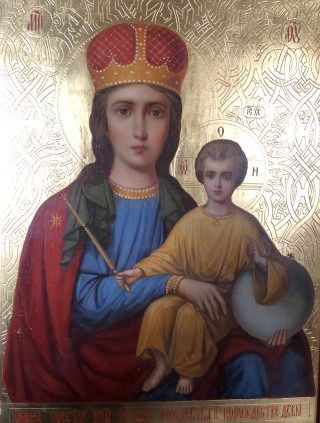
Commemorated on 17 (30) October
The icon was brought to the Nikolo-Peshnoshsky monastery by the famous Moscow merchant Alexei Grigorievich Mokeev, when he decided to join the fraternity in 1780. It was a family relic of the Mokeevs. Having donated all his funds to the monastery treasury, Alexei Grigorievich kept the image of the Mother of God in his cell. After his death in 1792, the icon became the property of the monastery. The abbot, seeing that the image was painted on canvas (rather than on a board) and not in full accordance with the generally accepted canon, ordered to place it outside the monastery walls, above the door leading to the chapel of St. Methodius Peshnoshsky.
The glorification of the holy icon began in 1827, after Platon Osipovich Shabashev, captain of the jaeger infantry regiment stationed near the monastery (in the village of Rogachevo), was passing by the chapel at night and saw an extraordinary light emanating from it. At that time, Shabashev was subjected to an unfair accusation, which served as the reason for his removal from his post. Not finding justice in the eyes of the earthly rulers, the captain decided to turn to the Heavenly Queen in his search of the truth. With bitter tears, he bowed down before Her most pure image in the monastery. A few days after that, at night, he heard the voice of the Mother of God, who appeared to him and said: “If you want to get rid of temptation, then arrange silver plating for the icon.” Shabashev fulfilled the command of the Mother of God. It was not long before he was acquitted.
A certain pious Platon told the abbot about the miracles coming from the icon, and he moved the holy image back into the monastery. When they wanted to put the plating on the miraculous icon, it turned out that the image painted on the canvas, was stretched over a board portraying the image of the Holy Virgin in a more elaborate writing.

Miracles from the icon were especially numerous during the time of cholera in 1848 when many who prayed before it received healing. The monastery was not influenced by cholera, despite the fact that its gates were always open to everyone, the guest house was full, and the monastics often went in processions of the cross to nearby villages and performed services instead of those parish priests who were sick or had died. In the same year, a service was drawn up and the day of the celebration of the icon was established for October 17. From that year on, the icon was located behind the temple’s choir gallery.
The image became even more famous in 1888 when its commemoration date coincided with the event of the royal family miraculously surviving the royal train crash on October 17. Returning to the capital, Emperor Alexander III gave orders to celebrate a thanksgiving prayer service to the image of the Mother of God “Before and After Giving Birth a Virgin” in all churches in Russia. Copies of the icon were then urgently made for many Russian churches.
In the pre-revolutionary period, the image was placed in the Intercession Monastery Church, near the relics of St Methodius Peshnoshsky. After the closure of the Nikolo-Peshnoshsky monastery in the 1920s, the original image was lost.

In modern times, a new copy was created for the revived monastery by the masters of the Trinity-Sergius Lavra. That copy was placed inside the St. Nicholas Cathedral of the monastery and also became famous for miracles. One of them took place on Sunday, March 17, 2019, on the Week of the Triumph of Orthodoxy when abundant myrrh-streaming of the venerated icon took place during the Divine Liturgy.
Icon Description
The icon is 12 vershoks* high by 9 wide. A bust-length image of the Mother of God is presented frontally, with the Eternal Child solemnly sitting on Her left hand. The Savior and His Mother are crowned with royal crowns. Jesus Christ holds the royal scepter in His right hand. With His left hand, the Infant God rests on the orb, which the Mother of God, as if helping Him, holds from below.
The liturgical basis of the icons of this edition is the liturgical text of the Theotokion (tone 7): “…O thou who before giving birth wast virgin, and during thy birthgiving wast virgin, thou remainest a Virgin even after giving birth.” The formation of iconography was influenced by such Western examples as the image of the Mother of God “Dreimal Wunderbare Mutter” (” Thrice Wondrous Mother “). Among other images known in Russia in terms of iconography, the icons of Lomovskaya, Shestokovskaya, Mishkovskaya, and Chubkovskaya from Starodubye are the closest.
Translated by The Catalogue of Good Deeds
Source: https://drevo-info.ru/articles/7604.html




